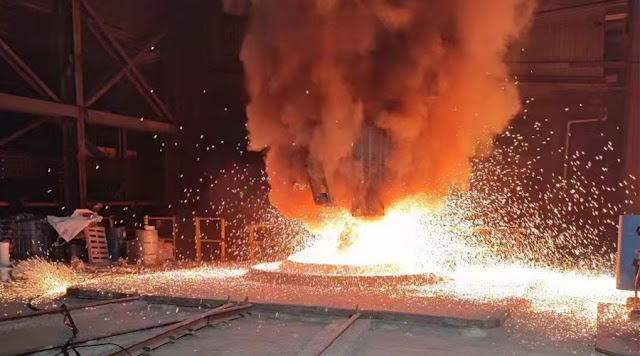Difference Between Arc And Induction Furnace
Electric arc furnaces and induction furnaces are commonly used cast steel smelting equipment in factories. They all have their own characteristics and advantages. Xi'an Hani Tech will share the difference between arc and induction furnace in the following 6 aspects.
1. Field of application
An electric arc furnace is an electric furnace that smelts ores and metals at high temperatures generated by electrode arcs. For smelting metals, the EAF is more flexible than other steelmaking furnaces. It can effectively remove impurities such as sulfur and phosphorus. The furnace temperature is easy to control and the equipment occupies a small area. It's suitable for smelting high-quality alloy steel. Electric arc furnaces are large in size and require high investment in equipment, generally more than 3 tons. Therefore, enterprises with a certain scale use electric arc furnace.
The medium frequency magnetic field has a magnetic stirring effect on the molten metal, which is beneficial to the uniform composition and scum. The installation and operation of the intermediate frequency induction furnace is very convenient, and it's convenient to replace the furnace body with different weights, different materials, and different starting methods to meet various melting requirements. Medium frequency induction furnace is suitable for various metal smelting and various casting processes. Compared with electric arc furnaces, intermediate frequency furnace steelmaking is low in cost and suitable for small and medium-sized enterprises.
2. Phosphorus, sulfur and deoxidation capacity
Electric arc furnaces are stronger than induction furnaces in terms of phosphorus, sulfur and deoxidation capabilities.
The induction furnace is a cold slag, and the temperature of the slag is maintained by the heat provided by the molten steel.
The electric arc furnace is a hot slag, and the slag is heated by an electric arc. The dephosphorization and desulfurization tasks can be completed through the slag, and the diffusion deoxidation can be fully performed through the slag.
Therefore, the removal of phosphorus, sulfur and deoxidation ability of EAF is better than that of induction furnace.
3. Nitrogen content
The nitrogen content in the steel smelted in the electric arc furnace is higher than that in the induction furnace, because the nitrogen molecules in the air in the high temperature zone of the arc are ionized into atoms and then absorbed by the molten steel.
The nitrogen content of the alloy smelted in the induction furnace is lower than that of the electric arc furnace, and the oxygen content is higher than that of the EAF. The rapid life value of the alloy is higher than that of the electric arc furnace.
4. Burnout rate
The yield of metal elements smelted by IF is higher than that by EAF. The volatilization and oxidation loss of elements is large under the high temperature of the arc.
The burning loss rate of metal elements in induction furnace smelting is lower than that in electric arc furnace. In particular, the burning loss rate of Taiwan elements in the returned material loaded with the furnace is much higher than that of the IF.
During induction furnace smelting, the metal element in the returned material can be effectively recovered. During electric arc furnace smelting, the metal element in the return material is first oxidized into the slag, and then reduced back to the molten steel from the slag, and its burning loss rate is obviously increased. When the return material is smelted, the recovery rate of metal elements in the IF is significantly higher than that in the EAF.
5. Carbon increase
The induction furnace relies on the principle of induction heating to melt the metal charge without carburizing the molten steel.
The electric arc furnace relies on graphite electrodes to heat the charge through an electric arc, and the molten steel will increase carbon after melting.
Under normal conditions, when smelting high-alloy nickel-chromium steel, the carbon content in electric arc furnace smelting is 0.06%, and it can reach 0.020% in induction furnace smelting.
The amount of carbon added in the EAF smelting process is 0.020%, and that of the IF is 0.010%.
Non-vacuum intermediate frequency induction furnaces is suitable for smelting low-carbon high-alloy steel and metal.
6. Data regulation
Induction furnace smelting is more convenient than electric arc furnace in controlling temperature, refining time, stirring intensity and maintaining constant temperature, and can be carried out at any time. It occupies a relatively important position in the smelting of high-alloy steel and alloys. It can produce products independently, and can also form a double-linked process with secondary refining such as electroslag remelting and vacuum self-consumption. Therefore, non-vacuum intermediate frequency induction furnace smelting has become an important smelting method for the production of high-speed steel, heat-resistant steel, stainless steel, electrothermal alloys, precision alloys, high-temperature alloys and other special steels and alloys, and has been widely used.
The above is the introduction of the difference between arc and induction furnace summarized by Xi'an Hani Tech engineers for you. After understanding these, do you have a clearer understanding of what type of metal heating equipment to choose for your factory project?
Xi'an Hani Tech Co., Ltd. is a professional manufacturer of induction heating equipment and metal smelting equipment in China. Focus on the R&D and production of iron and steel metal smelting heating equipment for many years. With advanced equipment technology, mature technology and strong engineer team, there are cases in many countries, and it's the best choice for many metal heating treatment plant projects.
For more information about the difference between arc and induction furnace or information about melting furnace, please feel free to contact us.
E-mail: saleswn@hanrm.com / inquiry66@hanmetallurgy.com ( Daisy )
Xi'an Hani Tech Co.,LTD.



Comments
Post a Comment